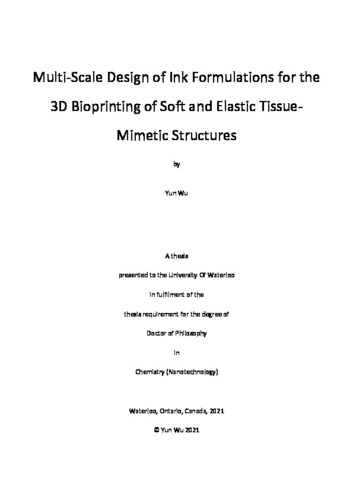| dc.description.abstract | Three-dimensional (3D) engineered tissue and organ models with adjustable biochemical and physical properties are needed in regenerative medicine. As such, 3D printing has emerged as a potential strategy to create more complex tissue-like constructs compared to conventional microfabrication techniques. It allows for precise positioning of biomaterials to create tissue constructs that imitate natural tissues and organs. Among 3D printing strategies, including extrusion-based, light-induced, and inkjet-based methods, the extrusion-based technique is broadly employed owing to its ease of use and compatibility with multi-material printing. However, the fabrication of accurate and precise human-mimetic functional 3D constructs still remains challenging. This thesis presents an investigation on the bioink material preparation from nano-, micro- to macro-scale to provide high structural resolution and cell viability and functionality.
Chapter 3 presents a strong shear-thinning, solid-like bioink employing alginate (1%), cellulose nanocrystals (CNCs) (3%), and gelatin methacryloyl (GelMA) (5%) (namely 135ACG hybrid ink) for the direct printing of cell-laden and acellular architectures. After crosslinking, the ACG gel can also provide a stiff extracellular matrix (ECM) ideal for stromal cell growth. By controlling the polymer concentration, a GelMA (4%) bioink was designed to encapsulate hepatoma cells (hepG2), as GelMA gel possesses the desired low mechanical stiffness matched human liver tissue. Four different versions of to-scale liver lobule-mimetic constructs were fabricated via ME bioprinting, with precise positioning of two different cell types (NIH/3T3 and hepG2) embedded in matching ECMs (135ACG and GelMA, respectively). The four versions allowed us to exam effects of mechanical cues and intercellular interactions on cell behaviors. Fibroblasts thrived in stiff 135ACG matrix and aligned at the 135ACG/GelMA boundary due to durotaxis, while hepG2 formed spheroids exclusively in the soft GelMA matrix. Elevated albumin production was observed in the bicellular 3D co-culture of hepG2 and NIH/3T3, both with and without direct intercellular contact, indicating that improved hepatic cell function can be attributed to soluble chemical factors. Overall, our results showed that complex constructs with multiple cell types and varying ECMs can be bioprinted and potentially be useful for both fundamental biomedical research and translational tissue engineering.
Chapter 4 presents a supporting bath-based embedded 3D printing strategy to fabricate large-scale architectures. Novel inks composed of 10 wt% glycidyl methacrylated poly(vinyl alcohol) (PVAGMA) with a different degree of substitution (DOS) and 4 wt% CNCs (PVAGMA(DOS)/CNC) with strong shear-thinning properties were developed. By controlling the DOS of PVAGMA and the crosslinking method, inks with the desired mechanical stiffness and toughness mimicking that of healthy arteries and arteries with atherosclerosis were designed to construct vascular phantoms. Cyclic tensile tests and an in-vitro hemodynamic study were performed on the hydrogels, illustrating that our ink compositions, namely PVAGMA2/CNC and PVAGMA4/CNC, possessed strong mechanical stability, durability, and recovery property. The burst circumferential tensile stress obtained from an in-vitro hemodynamic study and rupture tensile stress acquired under uniaxial test of PVAGMA2/CNC and PVAGMA4/CNC were comparable suggesting the optimal layer integrity and the mechanical strength was not influenced by the printing direction. Additionally, the burst pressure of our hydrogels was found to be about 90 mm Hg and the printed vascular phantoms were able to withstand a carotid pulse-mimetic pulsatile flow (60 beats/min with a peak flow rate of 27 mL/s) for over 10 days. Furthermore, with acoustic properties of PVAGMA/CNC hydrogels similar to those of human arteries, we demonstrated their capability in ultrasonics by embedded printing three different versions of straight vascular phantoms. B-mode imaging were performed on the phantoms to confirm the vessel dimensions and analyze vessel strain of the softer PVAGMA2/CNC and stiffer PVAGMA4/CNC. It was found that the vessel strain was 24.6% and 8.9% for PVAGMA2/CNC and PVAGMA4/CNC, respectively, demonstrating that the two bioink materials can be used for vessel-mimetic materials. It is anticipated that this artery phantom can serve as a platform to evaluate local arterial stiffness estimation algorithms. Overall, our results elucidated the great potential of the PVAGMA-based inks and granular supporting material to create biofunctional heterogeneous vasculature via embedded printing strategy for regenerative medicine and tissue engineering applications.
Taken all together, this thesis presents a comprehensive study on developing and characterizing various bioink materials and bioprinting cellular and acellular constructs via free-form or embedded printing strategy. Our developed bioink materials and ME-based printing methods offered new approaches to address the central challenges in tissue engineering to create heterogeneous constructs with varying ECMs to recapitulate biological functions. | en |

